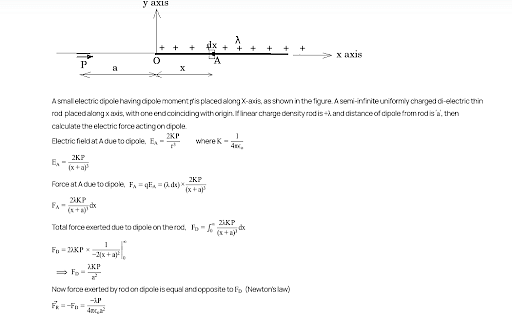A dipole is placed in an electric field as shown. In which direction will it move ?
- towards the left as its potential energy will increase.
- towards the right as its potential energy will decrease.
- towards the left as its potential energy will decrease.
- towards the right as its potential energy will increase.
The Correct Option is B
Solution and Explanation
The given problem involves a dipole placed in an electric field. To determine the direction in which the dipole will move, we need to consider the behavior of a dipole in an electric field.
When a dipole is placed in an electric field, the dipole experiences a torque that tends to align it with the field. The potential energy of the dipole in an electric field is given by:
U = -p · E
Where:
- p is the dipole moment vector,
- E is the electric field vector,
- U is the potential energy.
The dipole will move towards the direction where its potential energy decreases. This happens when the dipole rotates to align with the electric field, minimizing its potential energy.
In this case, as the dipole aligns with the electric field, it moves towards the right, where the potential energy is lower.
Final Answer:
The dipole will move towards the right as its potential energy will decrease.
Top Questions on Electric Dipole
- An electric dipole of dipole moment \(6 \times 10^{-6} \) Cm is placed in a uniform electric field of magnitude \(10^6\) V/m. Initially, the dipole moment is parallel to the electric field. The work that needs to be done on the dipole to make its dipole moment opposite to the field will be ________________________ J.
- JEE Main - 2025
- Physics
- Electric Dipole
- An electric dipole of mass \( m \), charge \( q \), and length \( l \) is placed in a uniform electric field \( E = E_0 \hat{i} \). When the dipole is rotated slightly from its equilibrium position and released, the time period of its oscillations will be:
- JEE Main - 2025
- Physics
- Electric Dipole
- An electric dipole with dipole moment \(p = 5 \times 10^{-6}\) Cm is aligned with the direction of a uniform electric field of magnitude \(E = 4 \times 10^5\) N/C. The dipole is then rotated through an angle of \(60^\circ\) with respect to the electric field. The change in the potential energy of the dipole is:
- NEET (UG) - 2025
- Physics
- Electric Dipole
- The distance between two equal and opposite charges of \( 0.2 \mu C \) will be 3.0 cm. Their electric dipole moment will be
- Bihar Board XII - 2025
- Physics
- Electric Dipole
- Inside a closed surface, n electric dipoles are situated. The electric flux coming out from the closed surface will be
- Bihar Board XII - 2025
- Physics
- Electric Dipole
Questions Asked in JEE Advanced exam
The center of a disk of radius $ r $ and mass $ m $ is attached to a spring of spring constant $ k $, inside a ring of radius $ R>r $ as shown in the figure. The other end of the spring is attached on the periphery of the ring. Both the ring and the disk are in the same vertical plane. The disk can only roll along the inside periphery of the ring, without slipping. The spring can only be stretched or compressed along the periphery of the ring, following Hooke’s law. In equilibrium, the disk is at the bottom of the ring. Assuming small displacement of the disc, the time period of oscillation of center of mass of the disk is written as $ T = \frac{2\pi}{\omega} $. The correct expression for $ \omega $ is ( $ g $ is the acceleration due to gravity):

- JEE Advanced - 2025
- Waves and Oscillations
- Consider the vectors $$ \vec{x} = \hat{i} + 2\hat{j} + 3\hat{k},\quad \vec{y} = 2\hat{i} + 3\hat{j} + \hat{k},\quad \vec{z} = 3\hat{i} + \hat{j} + 2\hat{k}. $$ For two distinct positive real numbers $ \alpha $ and $ \beta $, define $$ \vec{X} = \alpha \vec{x} + \beta \vec{y} - \vec{z},\quad \vec{Y} = \alpha \vec{y} + \beta \vec{z} - \vec{x},\quad \vec{Z} = \alpha \vec{z} + \beta \vec{x} - \vec{y}. $$ If the vectors $ \vec{X}, \vec{Y}, \vec{Z} $ lie in a plane, then the value of $ \alpha + \beta - 3 $ is ________.
- If $$ \alpha = \int_{\frac{1}{2}}^{2} \frac{\tan^{-1} x}{2x^2 - 3x + 2} \, dx, $$ then the value of $ \sqrt{7} \tan \left( \frac{2\alpha \sqrt{7}}{\pi} \right) $ is.
(Here, the inverse trigonometric function $ \tan^{-1} x $ assumes values in $ \left( -\frac{\pi}{2}, \frac{\pi}{2} \right) $.)- JEE Advanced - 2025
- Integral Calculus
Let $ a_0, a_1, ..., a_{23} $ be real numbers such that $$ \left(1 + \frac{2}{5}x \right)^{23} = \sum_{i=0}^{23} a_i x^i $$ for every real number $ x $. Let $ a_r $ be the largest among the numbers $ a_j $ for $ 0 \leq j \leq 23 $. Then the value of $ r $ is ________.
- JEE Advanced - 2025
- binomial expansion formula
- The total number of real solutions of the equation $$ \theta = \tan^{-1}(2 \tan \theta) - \frac{1}{2} \sin^{-1} \left( \frac{6 \tan \theta}{9 + \tan^2 \theta} \right) $$ is
(Here, the inverse trigonometric functions $ \sin^{-1} x $ and $ \tan^{-1} x $ assume values in $[-\frac{\pi}{2}, \frac{\pi}{2}]$ and $(-\frac{\pi}{2}, \frac{\pi}{2})$, respectively.)- JEE Advanced - 2025
- Inverse Trigonometric Functions
Concepts Used:
Electric Dipole
An electric dipole is a pair of equal and opposite point charges -q and q, separated by a distance of 2a. The direction from q to -q is said to be the direction in space.
p=q×2a
where,
p denotes the electric dipole moment, pointing from the negative charge to the positive charge.
Force Applied on Electric Dipole
